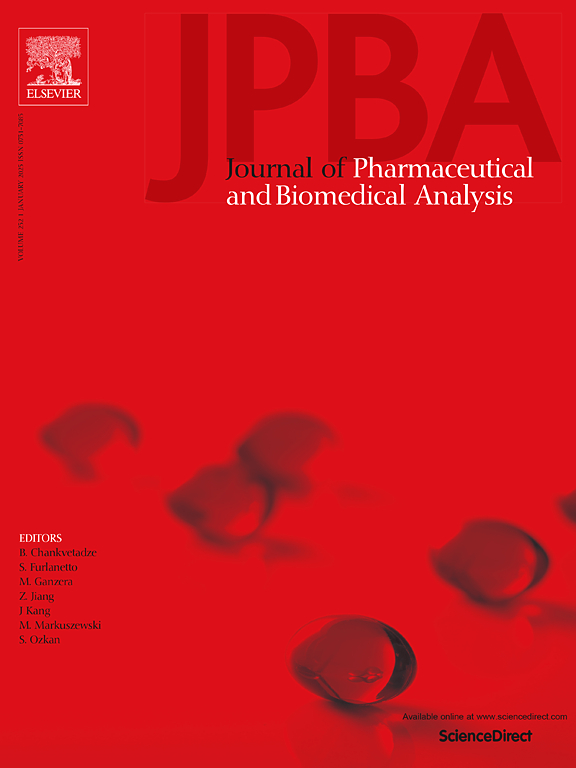Development and validation of a HPLC-MS/MS method the determination of genistein and equol in serum, urine and follicular fluid
IF 3.1
3区 医学
Q2 CHEMISTRY, ANALYTICAL
Journal of pharmaceutical and biomedical analysis
Pub Date : 2025-03-05
DOI:10.1016/j.jpba.2025.116800
引用次数: 0
Abstract
Soy isoflavones exert estrogen-like synergistic or antagonistic effects by binding to estrogen receptors, and potentially impact the function of female reproductive system, but their distribution profile in human remains little clarified. To determination of genistein (GEN) and equol (EQ) in human urine, serum and follicular fluid (FF), an analytical method based on high-performance liquid chromatography-tandem mass spectrometry (HPLC-MS/MS) was developed and validated. The enrichment and clean-up are performed on a solid-phase extraction (SPE) column; the elution is a gradient one, with the mobile phase (A) of 0.1 % (v/v) formic acid aqueous solution and the mobile phase (B) of 0.1 % (v/v) formic acid in acetonitrile; the column temperature is 40 °C. Mass spectrometry is performed using negative ion mode electrospray ionization (ESI -) in multiple reaction monitoring (MRM) mode. The method was validated over the linear ranges of 7.8–1000.0 ng/mL and 39.1–5000.0 ng/mL, for serum and urine, with correlation coefficients (r) of 0.9948–0.9984. The precision, accuracy and stability meet the U.S. Food and Drug Administration guidance. This method has been used to detect genistein (GEN) and equol (EQ) in serum, follicular fluid, and urine, to report equol in follicular fluid for the first time, and to study the correlation between genistein and equol in three body fluids. The study showed that the average concentration of EQ in follicular fluid was 18.5 ng/mL and there was a significant positive Spearman's correlation between concentrations of GEN in serum and FF (r = 0.44, p ≤ 0.05).
求助全文
约1分钟内获得全文
求助全文
来源期刊
CiteScore
6.70
自引率
5.90%
发文量
588
审稿时长
37 days
期刊介绍:
This journal is an international medium directed towards the needs of academic, clinical, government and industrial analysis by publishing original research reports and critical reviews on pharmaceutical and biomedical analysis. It covers the interdisciplinary aspects of analysis in the pharmaceutical, biomedical and clinical sciences, including developments in analytical methodology, instrumentation, computation and interpretation. Submissions on novel applications focusing on drug purity and stability studies, pharmacokinetics, therapeutic monitoring, metabolic profiling; drug-related aspects of analytical biochemistry and forensic toxicology; quality assurance in the pharmaceutical industry are also welcome.
Studies from areas of well established and poorly selective methods, such as UV-VIS spectrophotometry (including derivative and multi-wavelength measurements), basic electroanalytical (potentiometric, polarographic and voltammetric) methods, fluorimetry, flow-injection analysis, etc. are accepted for publication in exceptional cases only, if a unique and substantial advantage over presently known systems is demonstrated. The same applies to the assay of simple drug formulations by any kind of methods and the determination of drugs in biological samples based merely on spiked samples. Drug purity/stability studies should contain information on the structure elucidation of the impurities/degradants.

 求助内容:
求助内容: 应助结果提醒方式:
应助结果提醒方式:


